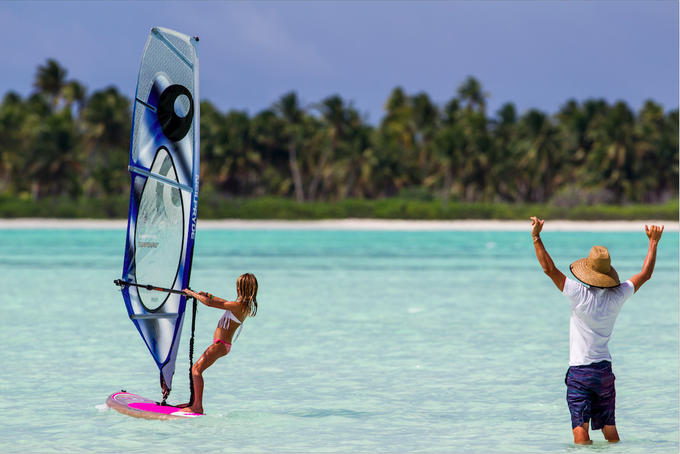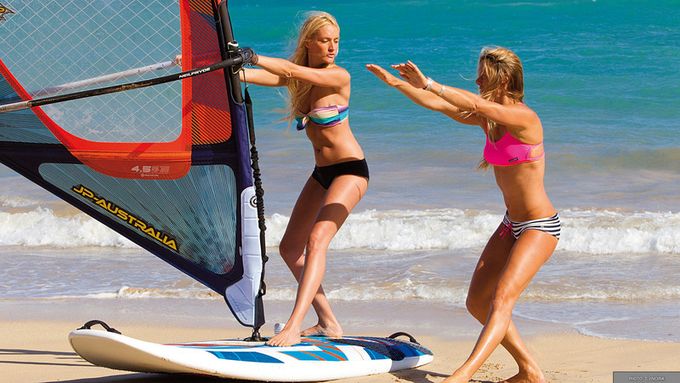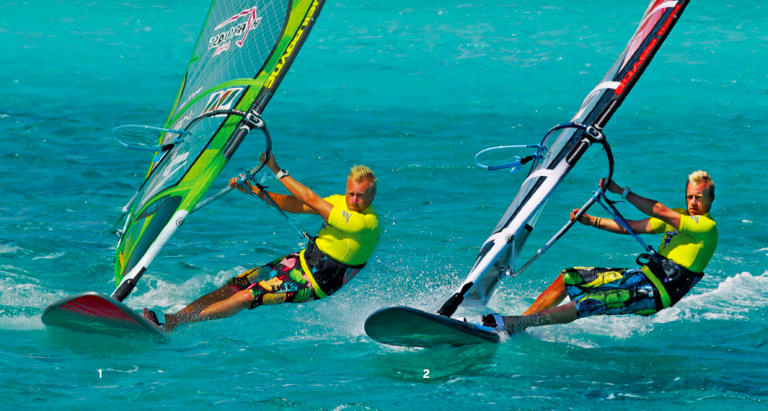Sarah Loughlin, a reformed non-windsurfer, gives us the lowdown on how to get your friends and family out on the water this year – that’s right it’s time to get them to learn to windsurf!
Ever sat in a cosy pub with your friends and loved ones looking longingly out at a storm wishing you were outside? If you’re reading this magazine then your answer is probably yes, but for most of the population it would be a resounding no. There are a select group of people to whom storms do not mean snuggling up on the sofa and watching TV. Storms mean wind and sometimes even waves, sending windsurfers rushing to their garages to dig out sails and boards and head down to the beach.
If you are one of these people so addicted to getting out on the water, that extreme weather warnings actually improve your weekend, read on.
Whether it’s a new partner, your kids, or your BFF it is always difficult when the people you spend time with don’t enjoy the same activities as you. But it doesn’t have to be that way. There is always the chance that you could get them onto to water too, especially with the warmer weather of the UK summer heading out way.
So, here are my five top tips for getting your loved-ones on the water and learning to windsurf:

-
A little bit of sunshine goes a long way
If it is too cold for a summer wetsuit, don’t even think about it. As seasoned water enthusiast getting down to your undies in the car park and then squeezing into a neoprene death suit is the norm. In fact, you love the rubbery damp smell that lingers in your car boot; but to a beginner there is nothing more unappealing. If it is winter/autumn wetsuit weather it’s ok if you are planing around, but if you are loitering in the shallows trying to remember which way the wind is coming from and where you are supposed to put your feet, it is mighty chilly! So, pick your timing wisely, wait until the sun is shining and the water is a bit warmer for their first day out on the water. Or why not suggest a holiday at a water sports centre where they have lots of different sports to choose from, such as tennis, biking, or even a spa! You can ease them in gently with a few nice mornings of windsurfing the sunshine.
-
Get some lessons.
Whatever you do, do not try to teach them yourself. This will not end well; it will be tears and afternoon of the silent treatment if you are lucky, and throwing long pointy pieces of windsurf equipment if you are not. Even if you are a qualified instructor and your students adore you, DON’T DO IT. Get them a few lessons, maybe as part of a group so they can learn the basics without a beachside domestic. There are great taster sessions available through out the UK for as little as £20. A good way to find a local school to you is through the RYA’s ‘Where’s My Nearest’ service.
-
No technical chat
If you do try to teach them yourself, or after they’ve got started with a trained professional, don’t make it too technical. Keep the ‘wind chat’ to an absolute minimum. They will not know where upwind is. They will not know what the leeward side of the board is. Make up silly non-technical names for things, and refer to land marks rather than upwind or downwind. I have now managed a few waterstarts without any understanding of where ‘upwind’ is. In fact the ‘U’ word is positively banned in polite conversation in our house. I normally settle for ‘towards the mountain’ or ‘towards the beach’ as suitable substitutes.

-
Never start a sentence with…
‘Oooh, well it’s a bit windy, I’m not sure you can manage…give it a try though’ or ‘Be careful there are rocks over there, and just behind the rocks there are a family of small but unfriendly sharks’. If your new windsurfer has not spent much time in the water they will be easily put off by tricky conditions, and will look to you for reassurance. If you do think it’s ok for them to go out, be really positive. For beginners a lot of it is confidence. If you don’t think it’s great conditions and they will struggle, let them know before they get their kit together. Be straight about it, but don’t scare them.
-
Give them your time
It is unlikely that you will be out sailing in the same conditions as them to start with, so spend some time after their lesson with them messing around in the water and showing some interest in how they are getting on. Once they get a little better you can sail together; but remember, even if it is THE BEST conditions you have ever sailed in – take 5 or 10 minutes out of your session to check in on them in the shallows. Showing that you are proud of them for how they are getting on will go a long way.
Happy sailing!


